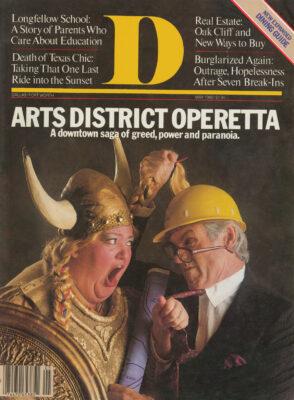Like other serious thinkers in Dallas, Erik Jonsson has spent time mulling over rapid transit.
The man most responsible for the building of the Dallas/Fort Worth Regional Airport and the new Dallas City Hall has decided the best bet would be to run trains on the city’s existing lines.
The city already owns Union Station, Jonsson points out. It has an opportunity to buy the Rock Island line, which skirts the southern boundary of the airport and then goes into downtown Fort Worth. “There’s no reason why you couldn’t switch to Denton Drive and have service to Love Field,” he says.
“And if you have the thing as far as Love Field, what’s the matter with taking the Katy into Highland Park and beyond,” the former mayor muses.
Jonsson says the rail also would be less expensive to experiment with than other systems.
But expense has never been something to stop the likes of developers John Stemmons, Trammell Crow and Ben Carpenter. These can-do types are backing a plan to build a light rail transit line from D/FW airport to Fair Park, a 23.4-mile corridor containing an estimated 350,000 jobs.
Stemmons’ industrial district, Crow’s Market Center and Carpenter’s Las Colinas development obviously would benefit from the rail service, but there is a real need for transit improvements along that route, and some sort of “transit way” -bus, light rail or high-speed “heavy” rail – has long been in the regional transportation plan, says Gordon Shunk, director of transportation and energy for the North Central Texas Council of Governments.
Whether the Crow-Car-penter-Stemmons plan will become reality depends on the Interim Regional Transportation Authority, which will draw up a full-service plan for the voters to consider prior to the transit authority referendum scheduled for early next year.
In that election, voters will be asked to approve creation of a transit authority, to be funded by a sales tax of no more than one percent, that would be charged with developing a mass transit system for the area. The IRTA is trying to do enough advance planning to let the voters know what they will get for their money.
IRTA chairwoman Adlene Harrison says the developers’ plan is being looked at very closely, along with ideas from other citizens and agencies. “What’s going to have the most impact on us is when we go out and talk to the public,” she says. “And when we choose the final corridors for the transportation plan, they will have to be backed by the statistics.”
The statistics, she added, will include information on current transit needs -which should make the Fair Park-D/FW route look good -and on projected needs -which might make it look even better. “If you are only planning for the current areas where you know there is congestion and you don’t plan even 10 or 20 years ahead, maybe the growth (patterns) will change things and you’ll be caught. That’s how we got where we are, by not planning ahead.”
One statistic that already has caught the IRTA’s eye is the dollar amount involved in the developers’ offer to provide right of way and rail stations along the route. Planners say right-of-way acquisition can amount to 25 percent of the $15 million to $18 million per mile construction costs of a light rail system. “With no federal funding for mass transit,” Mrs. Harrison says, “it is very attractive for us to look at anything like that.”
This may turn out to be another case of the public-private collaboration that created Reunion, Bryan Place and (we hope) the arts district.
Get our weekly recap
Brings new meaning to the phrase Sunday Funday. No spam, ever.
Related Articles

Hockey
What We Saw, What It Felt Like: Stars-Golden Knights, Game 3
A close final score masks a dominant performance.
By Sean Shapiro and David Castillo

Basketball
What We Saw, What It Felt Like: Mavs-Clippers Game 3
Little brother no more.
By Iztok Franko and Mike Piellucci

Local News
In a Friday Shakeup, 97.1 The Freak Changes Formats and Fires Radio Legend Mike Rhyner
Two reports indicate the demise of The Freak and its free-flow talk format, and one of its most legendary voices confirmed he had been fired Friday.


